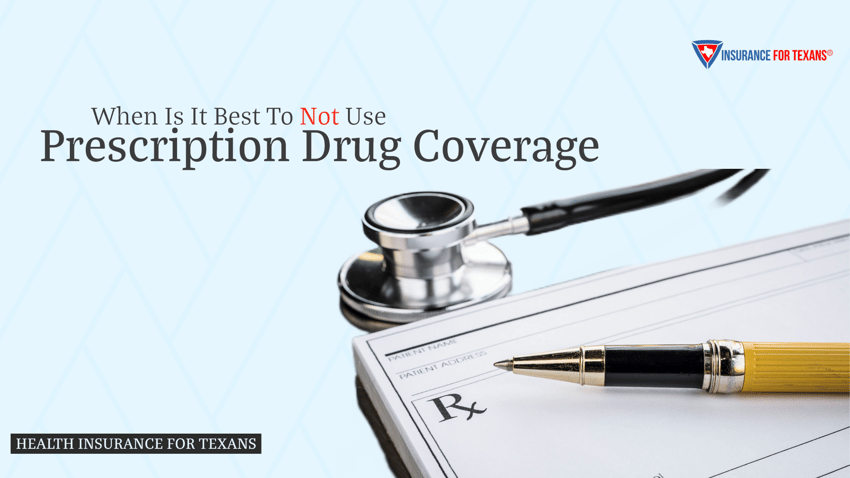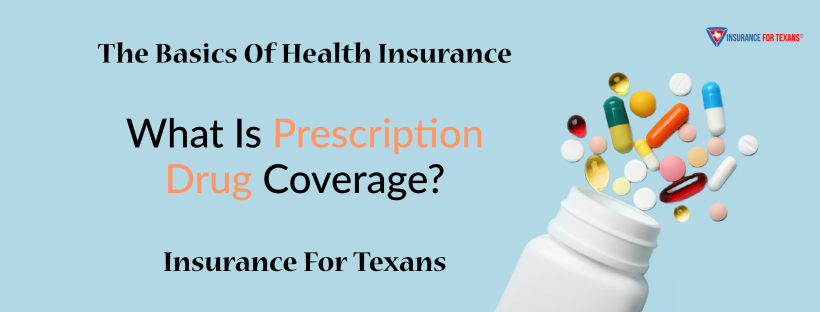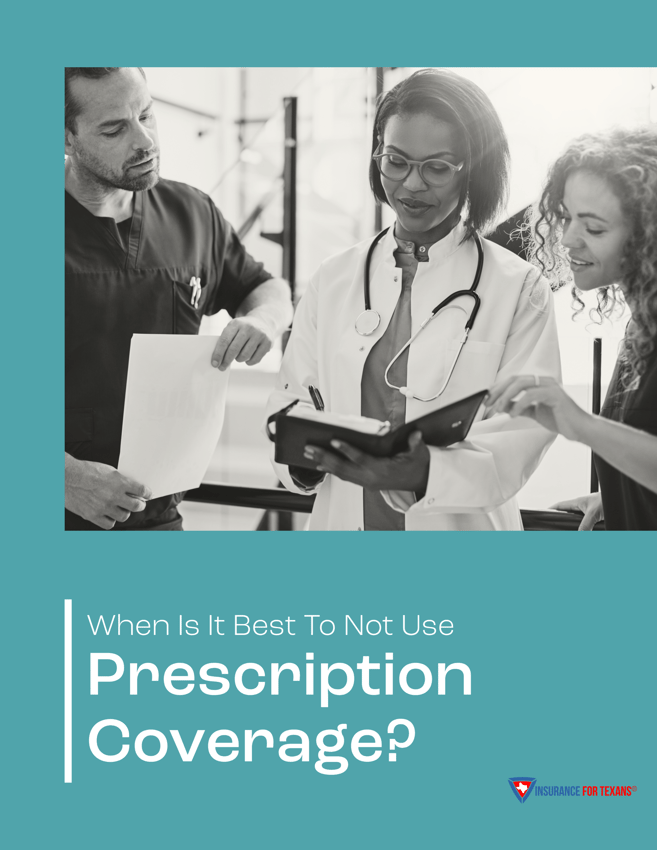Managing the cost of prescription drugs can be a daunting task for many individuals, especially those with chronic conditions requiring long-term medication. While prescription drug coverage provided by insurance plans can be beneficial in many cases, there are certain scenarios where it may not be the best financial decision. Let's explore the case of a young lady from Texas who made the decision to pay cash for her generic maintenance medications, rather than using her prescription drug coverage through insurance. This story sheds light on the complexities of prescription drug costs and highlights situations where exploring alternative options may be advantageous for individuals seeking affordable healthcare solutions.

Factors Affecting the Cost of Prescription Drugs
Prescription drug costs can vary greatly depending on several factors. For a young lady from Texas named Sarah, the cost of her generic maintenance medications led her to pay cash rather than using her prescription drug coverage through insurance. Most Texans are shocked when they hear this, but we like to break things down at Insurance For Texans so that you can understand for yourself.
The type of medication plays a significant role in determining its cost. Brand-name drugs tend to be more expensive than their generic counterparts. Since the young lady was taking generic medications, she was able to save money by paying cash instead of using her insurance coverage.
Another factor that can influence the cost of prescription drugs is the source of the medication. Different pharmacies and suppliers may have varying prices for the same medication. By shopping around and comparing prices, the young lady was able to find a pharmacy that offered her medications at a lower cost.
The duration of the treatment is also an important factor. Some medications may need to be taken for a short period, while others might require long-term use. In the case of maintenance medications, the young lady knew that she would be taking them regularly, so she opted to pay cash since the copayments through her prescription drug coverage would have been more expensive in the long run.
Generic Prescriptions vs Brand Name Prescriptions
Generic prescriptions and brand name prescriptions are two different options for medication, with varying costs and benefits. Generic prescriptions are typically less expensive than brand name prescriptions, while still containing the same active ingredients.
When a drug is developed, it is usually under patent protection, meaning that only the original manufacturer can produce and sell it. After the patent expires, other pharmaceutical companies can then produce a generic version of the drug. Generic drugs are required to have the same active ingredients, strength, dosage form, and route of administration as their brand name counterparts. They must also meet strict quality standards set by the Food and Drug Administration (FDA).
Popular examples of generic drugs and their brand name counterparts include:
- Generic version: ibuprofen / Brand name: Advil
- Generic version: sertraline / Brand name: Zoloft
- Generic version: simvastatin / Brand name: Zocor
By choosing the generic option, individuals can save money on their prescription costs without sacrificing the effectiveness of the medication. In the case of Sarah, opting to pay cash for her generic maintenance medications instead of using her prescription drug coverage through insurance allowed her to take advantage of the cost savings associated with generic prescriptions. To help you understand how she could make this decision, we must first understand how drug coverage works on health plans and also look at alternatives to obtaining your required medications.

What Is Prescription Drug Coverage?
Prescription drug coverage is a component of health insurance plans that helps individuals offset the cost of their prescription medications through premium payments and cost sharing. It typically includes a list of drugs that are covered, known as a formulary, and may have different drug tiers or levels of coverage depending on the type of medication. While prescription drug coverage can be beneficial for many, there are instances when it may be more cost-effective to pay cash for prescriptions rather than utilize the coverage provided by insurance. There are two key items that must be considered when evaluating a drug plan obtained through your health care benefits.
1. Copays vs Coinsurance
When you use your prescription coverage through your health plan, you will typically be required to share in the cost of the medication. This is done through either copays or coinsurance provisions on your health insurance plan. It is crucial to understand the difference between copays and coinsurance as they can wildly swing how much money comes out of your pocket when paying for a covered medication.
Copayments are fixed amounts that individuals pay for their covered prescriptions. For example, if someone has a copayment of $10 for a generic medication, they will always pay that fixed amount regardless of the actual cost of the drug. This can be advantageous for individuals who are on a budget or who need very predictable costs.
On the other hand, coinsurance is where you pay a percentage of the total cost of the drug. For instance, if someone has a coinsurance of 20% for a brand-name drug that costs $100, they would pay $20 while the insurance covers the remaining $80. This form of cost-sharing can result in higher out-of-pocket expenses for individuals, especially if they are expensive specialty drugs.
The exact copayment or coinsurance amount can vary depending on several factors. These factors include the specific drug being prescribed, whether it is a generic or brand-name drug, and the drug tier or level of coverage the drug falls into. Insurance plans may classify certain drugs as preferred or non-preferred, which can impact the cost-share amounts as well.
In some cases, individuals may find that paying cash for generic maintenance medications is more cost-effective than utilizing their prescription drug coverage. By opting to pay cash, individuals can bypass copayments or coinsurance percentages, potentially saving money in the long run. However, it is important to weigh this decision carefully and consult with health care providers to ensure that the chosen medications are equally effective as their brand-name counterparts.
Understanding the difference between copays and coinsurance, as well as the factors influencing these cost-sharing amounts, can enable individuals to make informed decisions when it comes to their prescription drug coverage.
2. Pay Attention To Formulary Lists
When it comes to managing prescription drug costs, it's essential to pay attention to formulary lists. These lists outline the covered drugs for a specific insurance plan and can greatly impact both coverage and drug costs. Formulary lists categorize medications into different tiers based on their cost and coverage. Higher-tier drugs generally have higher out-of-pocket costs for individuals which makes sense. Over the counter drugs will not typically be included in your formulary list as they are not considered a part of your prescription plan.
Understanding formulary lists is crucial for individuals to make informed decisions about their prescription drug coverage. It's essential to review the list to check if it covers specific medications prescribed by healthcare providers. Additionally, restrictions, such as prior authorization or step therapy requirements, should be considered when comparing coverage options. Learning how to find and check the formulary list for your specific health insurance plan is a key to using your prescription coverage smartly.
Considerations When Choosing a Plan
When it comes to choosing a prescription drug plan, there are several key considerations to keep in mind. Understanding these factors is essential to ensure that you select a plan that provides suitable coverage for your prescription medications.
One of the primary considerations when choosing a prescription drug plan is the monthly prescription drug plan premiums. These are the costs you pay to maintain coverage, regardless of whether you use prescription medications or not. Another crucial factor to evaluate is the formulary drug list. This is a list of medications that a plan covers.
Additionally, understanding the difference between copays and coinsurance is vital. Copays typically involve a fixed amount you pay for a medication, while coinsurance requires you to pay a percentage of the drug's cost. By comparing the formulary lists of different plans, you can determine which plan offers the most cost-effective coverage for your specific medications. Evaluating these considerations will help you make an informed decision and ensure that you select a plan that best suits your prescription medication needs.
What Are Alternatives Ways To Get Low Cost Prescriptions
When it comes to obtaining prescription medications, cost is often a primary concern for many individuals. In certain situations, it may be more affordable to explore alternative ways to acquire these medications rather than relying on prescription drug coverage. By considering factors such as monthly premiums, drug lists, copays, coinsurance, and formulary lists, you may discover alternatives ways to get low-cost prescriptions that better suited her healthcare needs. Let's delve into these considerations further to understand when it may be best to not use prescription drug coverage and explore alternative options for obtaining affordable medications.
Cash Pay For Prescriptions
Cash pay for prescriptions can be a viable alternative option for individuals who have insurance coverage but find that it is cheaper to pay out-of-pocket for their medications. If you are taking generic maintenance medications for a chronic condition, it can actually be more cost-effective than using prescription drug coverage through your insurance.
While cash pay for prescriptions can save individuals money, it is important to consider the potential drawbacks. Without utilizing prescription drug coverage, the cost of medications may not contribute to meeting deductible requirements, making it difficult to reach the point of having insurance coverage kick in for other healthcare services. Additionally, if someone requires multiple prescriptions or expensive drugs, the cost of paying out-of-pocket can quickly add up.
Fortunately, there are resources and programs available to help individuals afford their prescriptions when paying cash. Some pharmacies offer discount programs or price match guarantees. Prescription discount cards and coupons can also provide significant savings on medication costs. Furthermore, there are patient assistance programs and pharmacies that specialize in helping patients access affordable medications.
In certain situations, opting for cash pay for prescriptions can be a wise choice, especially for individuals who take generic maintenance medications and can find cheaper prices outside of their insurance coverage. It is important to evaluate the potential benefits and drawbacks, and to explore resources that may offer discounts or assistance for cash pay prescriptions.
Prescription Savings Clubs
Many Texans find themselves facing sky-high monthly premiums for prescription drug coverage whether through insurance plans or paying cash. Prescription savings clubs are membership programs that work alongside insurance or as a stand-alone option to help individuals save on their medication costs. These programs often offer discounts or lower prices on a wide range of prescription medications, making them an attractive option for those looking to cut back on their expenses.
Popular pharmacies like Walgreens and the Costco Prescription Program offer their own prescription savings clubs. By signing up for these clubs, you are able to access substantial savings on generic maintenance medications or even name brand drugs.
These prescription savings clubs provide a peace of mind that you can pay the lowest possible price for medications. By taking advantage of the discounts offered through these programs, Texans are able to significantly reduce out-of-pocket expenses and stretch budgets further.
Prescription savings clubs are a valuable resource for anyone looking to save on their drug costs. Whether it's through discounts, lower prices, or other money-saving initiatives, these programs can help alleviate the financial burden of prescription medications.
Good Rx and Cost Plus Drugs
If you are frustrated with the high cost of her prescription medications despite having prescription drug coverage through insurance, there are two front runners in helping you find lower cost cash prices for prescriptions. Good Rx and Cost Plus Drugs have become two online behemoths that are helping people find the absolute lowest cost on generic medications.
Good Rx is a prescription savings program that offers discounts on a wide range of generic medications. By using their website or mobile app, you can compare prices at different pharmacies that are local to you and find the lowest cost for your prescriptions. With Good Rx, it is not uncommon to save an average of 80% on the cash price of medications, significantly reducing out-of-pocket expenses.
Cost Plus Drugs is not a membership program, but an online pharmacy that provides access to discounted generic medications. Cost Plus Drugs focuses solely on generics, in a unique pricing model not found in any other setting in US Healthcare. They provide access to generics at their cost plus a 15% margin for profit. They only work via mail order, but are able to use their purchasing power to offer transparent pricing to you with no questions or gimmicks.
These two specific options work by negotiating lower prices with pharmacies and passing the savings on to the consumer. They are particularly helpful for individuals who don't have prescription drug coverage or who find that their insurance copayments are higher than the cash price.
By utilizing Good Rx and Cost Plus Drugs, you can lower her prescription drug costs and take control of your healthcare expenses without involving your insurance company or dealing with paper enrollment forms. Both Good Rx and Cost Plus Drugs are valuable tools for Texans who want to save on their prescription medication costs. With the rising costs of prescription drugs, utilizing these cost-saving opportunities can make a significant difference in individuals' budgets and overall healthcare expenses.

When Is It Best To Not Use Prescription Drug Coverage?
So now that we've learned about your options for filling prescriptions and how they work, let's travel back to Sarah. Our young lady from Texas who relies on maintenance medications to manage her chronic condition. Despite having prescription drug coverage through her Exchange Health Insurance plan, Sarah often finds herself questioning whether it's truly the best option for her. She takes generic medications that are readily available at most pharmacies, and after doing some research, she discovers that paying cash for her prescriptions is actually cheaper than using her insurance coverage. Intrigued by the idea of potentially saving more money, Sarah decides to explore when it is best to not use prescription drug coverage and weigh the potential benefits against the limitations. Here is a quick rundown of the top seven pros and cons of each side.
How to Save Money on Prescription Drugs
1. Explore Cost-Saving Programs:
State Pharmaceutical Assistance Programs (SPAPs) and patient assistance programs (PAPs) are valuable resources that offer financial assistance to eligible individuals. These programs can provide subsidies or even free medications to those who qualify financially and require high cost brand name drugs. Additionally, disease-specific funds may also offer assistance for particular conditions. Investigate and take advantage of these programs to reduce your prescription costs.
2. Opt for Affordable Generics:
Generic drugs are FDA-approved alternatives to brand-name medications, offering the same quality and effectiveness at a lower price. Talk to your healthcare provider or pharmacist about switching to generics whenever possible. Generic substitutes can significantly lower your out-of-pocket expenses.
3. Inquire for the "Best" Price:
When purchasing medications, don't be afraid to ask your pharmacist for the best price, even if you're not using your prescription drug coverage. Sometimes, the cash price can be lower than your copayment or deductible. Some pharmacy savings plans will also be cheaper than using your insurance coverage. Comparison shopping among different pharmacies can also help you find the most affordable option. GoodRX.com is a great place to sanity check for the "best" price.
4. Understand Coverage Rules:
When selecting or renewing your prescription drug coverage, carefully review the formulary, which is the list of covered drugs. Different plans may have different formularies and coverage rules. Ensure that your medications are on the list and consider any restrictions or authorization requirements. This helps avoid unexpected costs or denial of coverage for certain medications.
5. Low Number of Medications:
If you only take a few medications and they are affordable without insurance coverage, it might be more cost-effective to pay cash. It's not uncommon to find that generic maintenance medications are actually cheaper when paid out of pocket.
6. High Cost of Premiums and Cost Sharing:
Prescription drug coverage typically comes with monthly premiums and cost-sharing responsibilities, such as deductibles and copayments. If these costs outweigh the expense of paying for your medications directly, it may be more financially feasible to skip using your coverage.
7. Finding Alternative Ways:
Beyond paying cash for prescriptions, online options such as Cost Plus Drugs make for an awesome way to get medications at the rock bottom price. If your prescription can be filled in this way, you can rest assured knowing that you are being one of the best shoppers out there!
Get Help With Insurance For Texans
The reality for most Texans is that finding the best pricing for prescriptions can require a bit of legwork. But like Sarah, if you are paying more than $10 a month for a generic maintenance medication through your prescription copay you are likely to find more cost savings by moving to a cash priced alternative. And if that is the case, it also makes it easier for you to evaluate health plans at your next enrollment period since you won't have to worry about them being on the formulary list. And that freedom is something that all Texans crave.
The independent insurance agents at Insurance For Texans help their friends and neighbors to determine what path is best for their health insurance. Especially when medications are involved. It's important to have an advocate by your side to help you understand what your options are and how to leverage them to your advantage. If you want this kind of neighborly Texan help, simply click the button below to start your path to controlling your health insurance journey now!



